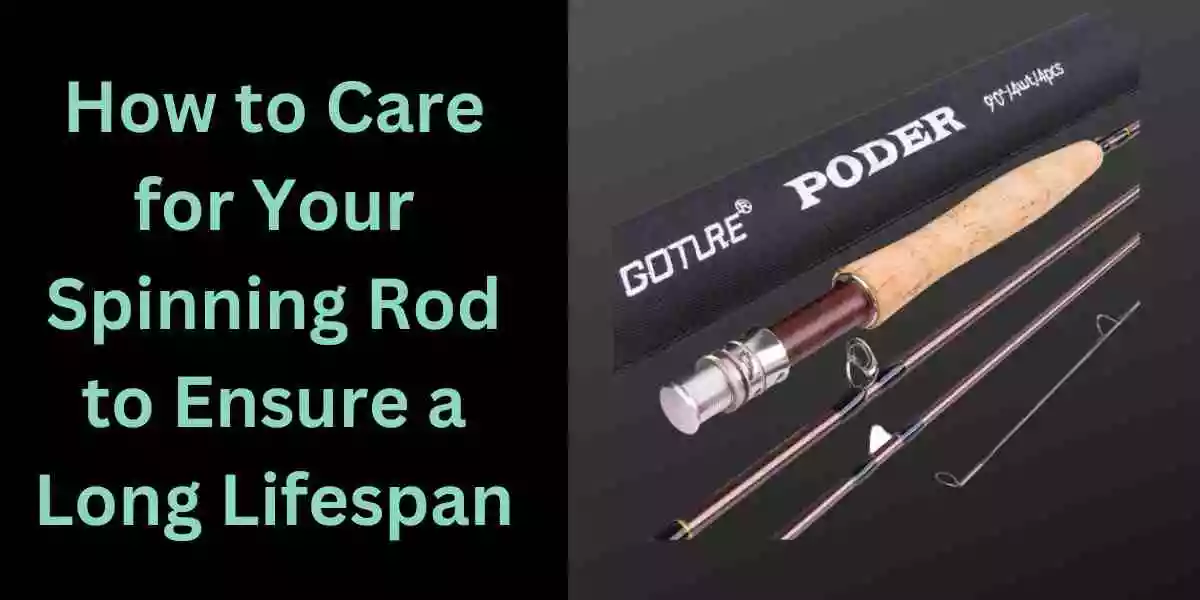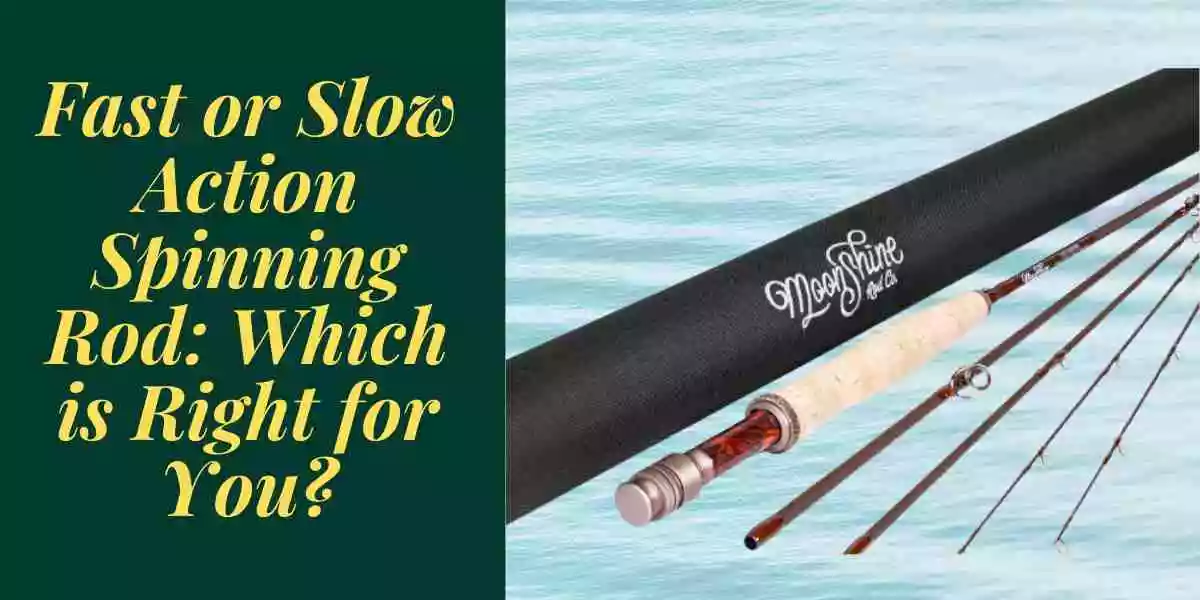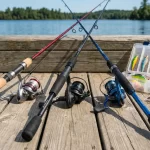Hey there, fellow angler! Are you ready to dive into the exciting world of fishing and take your skills to the next level? If so, then you’ll definitely want to master the art of using a spinning rod. This versatile tool is a must-have for any fishing enthusiast, whether you’re casting out from the shore or a boat.
But don’t worry if you’re new to fishing or just need a refresher – I’ve got you covered! In this easy-to-follow guide, I’ll walk you through the essential steps to caring for your spinning rod.
By following these tips and tricks, you’ll ensure that your rod performs at its best, lasts longer, and helps you reel in those prized catches. So let’s get started and give your spinning rod the tender love and care it deserves!
Table of contents
Quick Tips
To care for your spinning rod, start by choosing the right reel for your fishing needs. Ensure the reel matches the rod’s specifications and can handle the line weight and type you will use. This will ensure smooth and efficient casting, preventing strain on your rod.
Tip 2: Clean Your Rod Regularly
Keep your spinning rod clean to maintain its performance. After each fishing trip, rinse it with fresh water to remove any saltwater, dirt, or debris. Use a soft cloth or sponge to wipe it down and prevent rust or corrosion. Your rod will last longer and perform better when it’s kept clean.
Tip 3: Store Your Rod Properly
Proper storage is crucial for caring for your spinning rod. Avoid leaning it against a wall or leaving it exposed to sunlight, which can cause warping or damage. Use a rod sleeve or holder to store your rod vertically or horizontally, protecting it from accidental knocks or bending.
Tip 4: Check for Damage and Repairs
Regularly inspect your spinning rod for any signs of damage, such as cracks, loose guides, or worn-out grips. If you notice any issues, address them promptly to prevent further damage. Simple repairs like reattaching loose guides or replacing damaged grips can be done at home, but consult a professional or contact the manufacturer for more severe damage.
By following these tips, you can ensure your spinning rod stays in great shape, providing you with a reliable fishing tool for years.
Clean your spinning rod after each fishing session

Keeping your spinning rod clean after each fishing session is important for its longevity and optimal performance. Here’s a simple step-by-step guide to help you clean your spinning rod effectively.
First, start by removing the fishing reel from your rod. This can usually be done by loosening the reel seat and sliding the reel off. Once the reel is removed, use a soft cloth or brush to wipe away any dirt, debris, or residue that may have accumulated on both the rod and the reel. Be sure to pay attention to the guides and the handle as well, as these areas can often collect dirt and grime.
Next, fill a bucket or sink with warm water and add a small amount of mild dish soap. Gently submerge your spinning rod and reel into the soapy water and let them soak for a few minutes. While they are soaking, use a soft cloth or sponge to clean the rod thoroughly, paying attention to any stubborn spots of dirt. Rinse the rod and reel in clean water, making sure to remove all soapy residue. Finally, use a clean, dry cloth to towel-dry your rod and reel, ensuring that they are completely dry before storing them away.
By following these simple steps, you can easily maintain your spinning rod and keep it in top-notch condition for years to come. Regular cleaning will not only prolong the life of your rod but also ensure that it performs at its best when you’re out on the water. So, take a few minutes after each fishing session to clean your spinning rod and enjoy the benefits of a well-maintained and efficient fishing tool.
Inspect the rod guides for damage or wear regularly
A regular check of your fishing rod’s guides for damage or wear is an essential task for any angler. Start by gathering your rod and inspecting it closely. Carefully inspect each guide for any signs of damage, such as cracks or breaks. Additionally, check for signs of wear, such as grooves or rough edges on the guides. If you come across any issues, it’s crucial to address them promptly to ensure optimal fishing performance.
Next, clean the rod guides thoroughly to get a better view of any potential damage or wear. Use a soft cloth or a fishing rod cleaning tool to remove any dirt or debris. This step is crucial as it allows you to have a clearer view of the condition of the guides.
As you clean, inspect each guide again, paying close attention to any areas that may have been obscured by dirt. By having clean guides, you can more accurately assess their condition and identify any areas that may need repair or replacement.
Finally, once you have identified any damaged or worn guides, take the necessary steps to address the issue. If the damage is minor, you may be able to repair it yourself. For instance, small cracks can sometimes be fixed with a small amount of epoxy glue.
However, if the damage is severe or you are unsure about making the repair, it’s best to consult with a professional or take your rod to a local fishing shop for assistance. Remember, keeping your rod guides in good condition is crucial for optimal casting and ensuring a successful fishing experience.
Store your spinning rod in a rod case or sleeve
You can protect your spinning rod by storing it properly, which is one of the most important things you can do. To ensure its safety, I recommend investing in a rod case or sleeve. These protective covers are designed to keep your rod safe from damage during transport or storage.
To store your spinning rod in a rod case or sleeve, start by selecting a case that is the appropriate size for your rod. Make sure the rod fits snugly inside the case without bending or putting strain on the rod. Once you have the right case, simply slide your spinning rod into it, taking care to secure it properly. Many rod cases have straps or Velcro closures to keep your rod in place.
When storing your spinning rod, it’s important to find a safe and convenient location. Keep in mind that your rod should be stored in a dry and cool area, away from any potential hazards. Avoid storing it near sharp objects or in extreme temperatures that could damage the rod. By following these steps and storing your spinning rod in a rod case or sleeve, you can ensure that it remains in excellent condition for years to come.
Replace worn-out reel seats or grips for optimal performance
Replacing worn-out reel seats or grips is a simple process that can significantly improve your fishing performance. To begin, gather the necessary tools: a screwdriver, pliers, and a replacement reel seat or grip. Next, remove the old reel seat or grip by loosening the screws with a screwdriver.
Once loosened, use pliers to gently wiggle and pull the old reel seat or grip off the fishing rod. Be careful not to damage the rod while doing so. Now that the old reel seat or grip is removed, it’s time to attach the new one.
Simply align the holes of the new reel seat or grip with those on the fishing rod and secure them using the screws. Make sure to tighten the screws firmly, but be careful not to overtighten and risk damaging the rod. With your new reel seat or grip in place, you’re now ready to enjoy optimal performance on your fishing trips.
Conclusion
Taking care of your spinning rod is crucial for its longevity and ensuring optimal performance each time you take it out on the water. By implementing these outlined strategies – cleaning your rod after each fishing session, regularly inspecting the rod guides for damage or wear, and storing it in a rod case or sleeve – you can significantly improve the lifespan of your spinning rod.
This will save you money in the long run and enhance your fishing experience, as a well-maintained rod will provide better sensitivity and smoother casting.
So, take the time to care for your spinning rod, and reap the rewards of a more enjoyable and successful day on the water.
FAQs
Why is it important to take care of my spinning rod?
Taking care of your spinning rod helps maintain its performance, prolongs its lifespan, and ensures you have an enjoyable fishing experience. Neglecting proper care can result in damage, reduced performance, and costly repairs or replacements.
How should I clean my spinning rod after each use?
Cleaning your spinning rod after each use helps remove dirt, debris, and saltwater that may accumulate. Start by rinsing it with fresh water, paying attention to the guides, reel seat, and handle. Use a soft cloth or sponge to wipe down the rod, and gently dry it before storing.
When should I lubricate the reel on my spinning rod?
Lubricating the reel on your spinning rod is crucial to maintain smooth operation. It’s recommended to lubricate it periodically, especially if you frequently use it in saltwater or notice any signs of squeaking or resistance. Refer to your reel’s user manual for specific instructions on lubrication.
How can I prevent my spinning rod from getting damaged during transport?
To protect your spinning rod during transport, consider using a rod case or tube specifically designed for that purpose. These cases provide cushioning and help prevent any accidental impacts or excessive bending that could result in damage. Additionally, handle your rod with care while setting it up or dismantling it.
Is it necessary to store my spinning rod a certain way?
Proper storage of your spinning rod helps maintain its shape and prevents warping, scratches, or other damage. It’s best to store your rod in a cool, dry place when not in use. Avoid leaning it against walls or other objects that could cause misalignment or pressure on the guides.
What should I do if my spinning rod gets wet?
If your spinning rod gets wet, be sure to dry it thoroughly before storing it. Wipe it down with a soft cloth or towel to remove any excess moisture and allow it to air dry completely. Avoid storing a wet rod as it may promote mould or mildew growth.
How often should I inspect my spinning rod for damage?
Regular inspections of your spinning rod are essential to catch any potential issues early on. It is recommended to examine your rod before and after each fishing trip. Pay close attention to the guides, rod blank, reel seat, and handle for any signs of wear, cracks, loose parts, or other damage.
Can I repair my spinning rod on my own if it gets damaged?
Some minor repairs, such as fixing loose guide wraps or replacing a damaged tip, can be done at home with the right tools and guidance. However, for major repairs or structural damages, it’s advisable to consult a professional rod repair service to ensure proper restoration without compromising its integrity.
Are there any additional tips for caring for my spinning rod?
Here are a few additional tips:
Remember, taking good care of your spinning rod will help it last longer and enhance your fishing experience.
You may also like 📖
-
10 Best Spinning Reel for Trout in 2023 (Buying Guide Review)
-
10 Best Saltwater Spinning Reels Under $100 – Ultimate Guide
-
10 Best River Trout Fishing Rods For 2023 Season: Expert Buying Guide
-
Can Baitcasters Improve Casting Accuracy More Than Spinning Rods?
-
What Length Spinning Rods Do You Need: (Finding the Perfect Fit)
-
How to Spool a Spinning Reel Like a Pro – Conquer Line Twist and Cast Like a Champion









I may need your help. I tried many ways but couldn’t solve it, but after reading your article, I think you have a way to help me. I’m looking forward for your reply. Thanks.